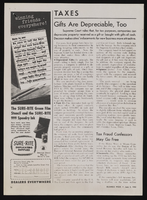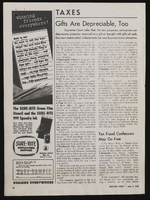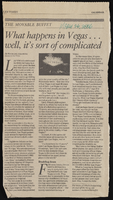Search the Special Collections and Archives Portal
Search Results

The Beat Coffeehouse Neon Survey document, September 17, 2017
Date
Archival Collection
Description
Site address: 520 Fremont St
Sign owner: Michael and Jennifer Cornthwaite
Sign details: This location opened in 2009, but closed in 2016. It will reopen as Eureka!, which is a chain of restaurants based in California.
Sign condition: 5- was a relatively new sign and shined brightly
Sign form: Hanging sign
Sign-specific description: This sign was skeletal neon making the letters "the beat" in a bubble letter font. The word 'the' lights up blue and 'beat' is red neon.
Sign - type of display: Neon
Sign - media: Steel
Sign environment: This location is in the Fremont East District on Fremont and 6th Street in the Emergency Arts Center.
Sign - date of redesign/move: Currently this sign is not visible from public view
Sign - thematic influences: This sign showcases a good use of skeletal neon.
Sign - artistic significance: The property's decor is representative of the bohemian, indie, hipster trend of the mid 2000s into the the 2010s.
Survey - research locations: Review Journal article https://www.reviewjournal.com/entertainment/food/the-beat-coffeehouse-in-downtown-las-vegas-to-close-later-this-year/ , The Beat website http://www.thebeatlv.com/ , Las Vegas Weekly article https://lasvegasweekly.com/intersection/2016/jul/12/losing-the-beat-coffeehouse-detriment-to-downtown/ , Vegas Eater website https://vegas.eater.com/2016/9/26/13051480/the-beat-coffeehouse-closes
Surveyor: Wyatt Currie-Diamond
Survey - date completed: 2017-09-17
Sign keywords: Neon; Hanging
Text
Harrah’s Entertainment Corporate Archives
Identifier
Abstract
The Harrah’s Entertainment Corporate Archives (dating from 1811 to 2004 with the bulk of the materials dating from 1940 to 2000) contain the promotional and corporate files of Harrah’s Entertainment Inc. and its predecessors, as well as Bill Harrah’s personal papers and card game collection. The materials were compiled and developed as a corporate archive by Harrah's Entertainment, Inc.’s Corporate Communications Department. The collection is primarily comprised of casino and employee periodicals, reports, manuals, promotional files, ephemera, and newspaper articles that document Bill Harrah’s casinos in Reno, Nevada and Lake Tahoe as well as Harrah’s Inc., Holiday Inns, Inc., Holiday Corporation, the Promus Companies, and Harrah’s Entertainment, Inc. Also included are photographs that document the construction of Harrah’s properties, business operations, the people who worked and performed at Harrah’s properties, and Bill Harrah’s automobile collection. The collection also contains Bill Harrah’s collection of playing cards and card games. Also included are photographs of the Harrah family.
Archival Collection
Elton and Madelaine Garrett Photograph and Architectural Drawing Collection
Identifier
Abstract
The Elton and Madelaine Garrett Photograph and Architectural Drawing Collection contains photographic prints and architectural drawings of Boulder (Hoover) Dam; Las Vegas, Nevada; Boulder City, Nevada; and other locations in the American Southwest from approximately 1927 to 1990. The photographs primarily depict Hoover Dam's construction and areas around Hoover Dam, Las Vegas, and Boulder City during the 1930s and 1940s. The bulk of the architectural drawings and maps are projects and diagrams related to the planning and development of Boulder City, Nevada between 1943 and 1985.
Archival Collection

Joy Rineer oral history interview: transcript
Date
Archival Collection
Description
Oral history interview with Joy Rineer conducted by Claytee D. White on December 07, 2017 for the Remembering 1 October Oral History Project. In this interview, Rineer discusses her upbringing in Las Vegas, Nevada. She describes her career as an architect, designing the Resilience Center for those affected by the 1 October shooting, and the city’s response to the shooting. Later, Rineer describes helping the grief-stricken city through architecture, establishing the Leadership Las Vegas program, and organizing blood drives. Lastly, Rineer discusses the changes in Las Vegas after the tragedy.
Text
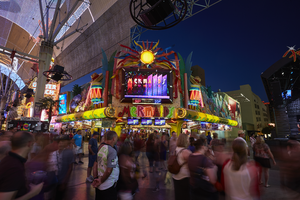
Photographs of Mermaids Casino signs, Las Vegas (Nev.), June 24, 2016
Date
Archival Collection
Description
Site address: 32 Fremont St
Sign owner: Derek and Greg Stevens
Sign details: Shutdown in 2016, opened briefly June 28th, 2017 for 8 hours to abide by gambling license law, was torn down shortly after. 2.76 acre lot, originally built in 1949.
Sign condition: Signage was removed from building during deconstruction
Sign form: Decorated shed
Sign-specific description: Covering all the sides of the Mermaids facing Fremont street, gives the feel of New Orleans during Mardi Gras with its bright vibrant colors, drums, maracas, and other items. Skeleton neon was used to accentuate features of the sign like details in the drums, outlining the word "Mermaids", and a good portion of the sign was internally lit as well. Giant TV screen hung in the middle at the corner of the building, giant Sun shaped pinata thing above the TV screen adding more to the theme.
Sign - type of display: Neon, LED screen
Sign - media: Steel and fiberglass
Sign - non-neon treatments: LED screen
Sign animation: Animated with an LED TV screen and some neon would flash on and off
Sign environment: Downtown on Fremont Street, part of the Experience. Surrounded by other casinos and gift stores.
Sign - date of installation: c. 1999
Sign - date of redesign/move: Torn down Summer 2017
Sign - thematic influences: Southern party themed, Mardi Gras.
Sign - artistic significance: American South and Mardi Gras.
Survey - research locations: Vital Vegas, Assessor's website
Surveyor: Danny Jacobs
Survey - date completed: 2017-09-09
Sign keywords: Neon; Steel; Fiberglass; Flashing; Video screen; Sculptural
Mixed Content
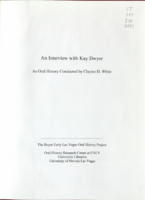
Transcript of interview with Kay C. Dwyer by Claytee D. White, August 16, 2000
Date
Archival Collection
Description
Text

